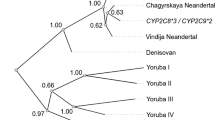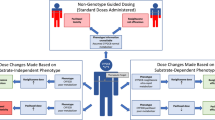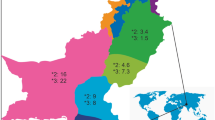Abstract
Cytochrome P450 2C9 (CYP2C9) metabolizes many clinically important drugs including warfarin and diclofenac. We have recently reported a new allelic variant, CYP2C9*35, found in a warfarin hypersensitive patient with Arg125Leu and Arg144Cys mutations. Here, we have investigated the molecular basis for the functional consequences of these polymorphic changes. CYP2C9.1 and CYP2C9-Arg144Cys expressed in human embryonic kidney 293 cells effectively metabolized both S-warfarin and diclofenac in NADPH-dependent reactions, whereas CYP2C9-Arg125Leu or CYP2C9.35 were catalytically silent. However, when NADPH was replaced by a direct electron donor to CYPs, cumene hydroperoxide, hereby bypassing the CYP oxidoreductase (POR), all variant enzymes were active, indicating unproductive interactions between CYP2C9.35 and POR. In silico analysis revealed a decrease of the electrostatic potential of CYP2C9-Arg125Leu-POR interacting surface and the loss of stabilizing salt bridges between these proteins. In conclusion, our data strongly suggest that the Arg125Leu mutation in CYP2C9.35 prevents CYP2C9-POR interactions resulting in the absence of NADPH-dependent CYP2C9-catalyzed activity in vivo, thus influencing the warfarin sensitivity in the carriers of this allele.
This is a preview of subscription content, access via your institution
Access options
Subscribe to this journal
Receive 6 print issues and online access
$259.00 per year
only $43.17 per issue
Buy this article
- Purchase on Springer Link
- Instant access to full article PDF
Prices may be subject to local taxes which are calculated during checkout






Similar content being viewed by others
References
Lohr JW, Willsky GR, Acara MA . Renal drug metabolism. Pharmacol Rev 1998; 50: 107–141.
Hrycay EG, Gustafsson JA, Ingelman-Sundberg M, Ernster L . Sodium periodate, sodium chloride, organic hydroperoxides, and H2O2 as hydroxylating agents in steroid hydroxylation reactions catalyzed by partially purified cytochrome P-450. Biochem Biophys Res Commun 1975; 66: 209–216.
Barr DP, Martin MV, Guengerich FP, Mason RP . Reaction of cytochrome P450 with cumene hydroperoxide: ESR spin-trapping evidence for the homolytic scission of the peroxide O–O bond by ferric cytochrome P450 1A2. Chem Res Toxicol 1996; 9: 318–325.
Rendic S, Di Carlo FJ . Human cytochrome P450 enzymes: a status report summarizing their reactions, substrates, inducers, and inhibitors. Drug Metab Rev 1997; 29: 413–580.
Zanger UM, Schwab M . Cytochrome P450 enzymes in drug metabolism: regulation of gene expression, enzyme activities, and impact of genetic variation. Pharmacol Therap 2013; 138: 103–141.
Eriksson N, Wadelius M . Prediction of warfarin dose: why, when and how? Pharmacogenomics 2012; 13: 429–440.
Johnson JA, Gong L, Whirl-Carrillo M, Gage BF, Scott SA, Stein CM et al. Clinical Pharmacogenetics Implementation Consortium Guidelines for CYP2C9 and VKORC1 genotypes and warfarin dosing. Clin Pharmacol Ther 2011; 90: 625–629.
Yin T, Miyata T . Warfarin dose and the pharmacogenomics of CYP2C9 and VKORC1—rationale and perspectives. Thromb Res 2007; 120: 1–10.
Yasar U, Eliasson E, Forslund-Bergengren C, Tybring G, Gadd M, Sjoqvist F et al. The role of CYP2C9 genotype in the metabolism of diclofenac in vivo and in vitro. Eur J Clin Pharmacol 2001; 57: 729–735.
Yasar U, Forslund-Bergengren C, Tybring G, Dorado P, Llerena A, Sjoqvist F et al. Pharmacokinetics of losartan and its metabolite E-3174 in relation to the CYP2C9 genotype. Clin Pharmacol Ther 2002; 71: 89–98.
Rokitta D, Fuhr U . Comparison of enzyme kinetic parameters obtained in vitro for reactions mediated by human CYP2C enzymes including major CYP2C9 variants. Curr Drug Metab 2010; 11: 153–161.
Crespi CL, Miller VP . The R144C change in the CYP2C9*2 allele alters interaction of the cytochrome P450 with NADPH:cytochrome P450 oxidoreductase. Pharmacogenetics 1997; 7: 203–210.
Williams PA, Cosme J, Ward A, Angove HC, Matak Vinkovic D, Jhoti H . Crystal structure of human cytochrome P450 2C9 with bound warfarin. Nature 2003; 424: 464–468.
Wester MR, Yano JK, Schoch GA, Yang C, Griffin KJ, Stout CD et al. The structure of human cytochrome P450 2C9 complexed with flurbiprofen at 2.0-A resolution. J Biol Chem 2004; 279: 35630–35637.
Hata M, Hirano Y, Hoshino T, Tsuda M . Monooxygenation mechanism by cytochrome p-450. J Am Chem Soc 2001; 123: 6410–6416.
Hata M, Tanaka Y, Kyoda N, Osakabe T, Yuki H, Ishii I et al. An epoxidation mechanism of carbamazepine by CYP3A4. Bioorg Med Chem 2008; 16: 5134–5148.
Li W, Liu H, Scott EE, Grater F, Halpert JR, Luo X et al. Possible pathway(s) of testosterone egress from the active site of cytochrome P450 2B1: a steered molecular dynamics simulation. Drug Metab Dispos 2005; 33: 910–919.
Li W, Liu H, Luo X, Zhu W, Tang Y, Halpert JR et al. Possible pathway(s) of metyrapone egress from the active site of cytochrome P450 3A4: a molecular dynamics simulation. Drug Metab Dispos 2007; 35: 689–696.
Li W, Tang Y, Liu H, Cheng J, Zhu W, Jiang H . Probing ligand binding modes of human cytochrome P450 2J2 by homology modeling, molecular dynamics simulation, and flexible molecular docking. Proteins 2008; 71: 938–949.
Sano E, Li W, Yuki H, Liu X, Furihata T, Kobayashi K et al. Mechanism of the decrease in catalytic activity of human cytochrome P450 2C9 polymorphic variants investigated by computational analysis. J Comput Chem 2010; 31: 2746–2758.
Ciccacci C, Falconi M, Paolillo N, Oteri F, Forte V, Novelli G et al. Characterization of a novel CYP2C9 gene mutation and structural bioinformatic protein analysis in a warfarin hypersensitive patient. Pharmacogenet Genom 2011; 21: 344–346.
Bradford MM . A rapid and sensitive method for the quantitation of microgram quantities of protein utilizing the principle of protein–dye binding. Anal Biochem 1976; 72: 248–254.
Edwards RJ, Adams DA, Watts PS, Davies DS, Boobis AR . Development of a comprehensive panel of antibodies against the major xenobiotic metabolising forms of cytochrome P450 in humans. Biochem Pharmacol 1998; 56: 377–387.
Lang D, Bocker R . Highly sensitive and specific high-performance liquid chromatographic analysis of 7-hydroxywarfarin, a marker for human cytochrome P-4502C9 activity. J Chromatogr B 1995; 672: 305–309.
Inoue T, Nitta K, Sugihara K, Horie T, Kitamura S, Ohta S . CYP2C9-catalyzed metabolism of S-warfarin to 7-hydroxywarfarin in vivo and in vitro in chimeric mice with humanized liver. Drug Metab Dispos 2008; 36: 2429–2433.
Zhao Q, Modi S, Smith G, Paine M, McDonagh PD, Wolf CR et al. Crystal structure of the FMN-binding domain of human cytochrome P450 reductase at 1.93 A resolution. Protein Sci 1999; 8: 298–306.
Sevrioukova IF, Li H, Zhang H, Peterson JA, Poulos TL . Structure of a cytochrome P450-redox partner electron-transfer complex. Proc Natl Acad Sci USA 1999; 96: 1863–1868.
Pettersen EF, Goddard TD, Huang CC, Couch GS, Greenblatt DM, Meng EC et al. UCSF Chimera—a visualization system for exploratory research and analysis. J Comput Chem 2004; 25: 1605–1612.
Hubbard SJ, Thornton JM, Campbell SF . Substrate recognition by proteinases. Faraday Discuss 1992; 93: 13–23.
Dominguez C, Boelens R, Bonvin AM . HADDOCK: a protein–protein docking approach based on biochemical or biophysical information. J Am Chem Soc 2003; 125: 1731–1737.
Dolinsky TJ, Nielsen JE, McCammon JA, Baker NA . PDB2PQR: an automated pipeline for the setup of Poisson–Boltzmann electrostatics calculations. Nucleic Acids Res 2004; 32: W665–W667.
Wang JCP, Kollman PA . How well does a restrained electrostatic potential (RESP) model perform in calculating conformational energies of organic and biological molecules? J Comput Chem 2000; 21: 1049–1074.
Oda A, Yamaotsu N, Hirono S . New AMBER force field parameters of heme iron for cytochrome P450s determined by quantum chemical calculations of simplified models. J Comput Chem 2005; 26: 818–826.
Baker NA, Sept D, Joseph S, Holst MJ, McCammon JA . Electrostatics of nanosystems: application to microtubules and the ribosome. Proc Natl Acad Sci USA 2001; 98: 10037–10041.
Hrycay EG, Gustafsson JA, Ingelman-Sundberg M, Ernster L . The involvement of cytochrome P-450 in hepatic microsomal steroid hydroxylation reactions supported by sodium periodate, sodium chlorite, and organic hydroperoxides. Eur J Biochem 1976; 61: 43–52.
Hasemann CA, Kurumbail RG, Boddupalli SS, Peterson JA, Deisenhofer J . Structure and function of cytochromes P450: a comparative analysis of three crystal structures. Structure 1995; 3: 41–62.
Bridges A, Gruenke L, Chang YT, Vakser IA, Loew G, Waskell L . Identification of the binding site on cytochrome P450 2B4 for cytochrome b5 and cytochrome P450 reductase. J Biol Chem 1998; 273: 17036–17049.
Im SC, Waskell L . The interaction of microsomal cytochrome P450 2B4 with its redox partners, cytochrome P450 reductase and cytochrome b(5). Arch Biochem Biophys 2011; 507: 144–153.
Juvonen RO, Iwasaki M, Negishi M . Roles of residues 129 and 209 in the alteration by cytochrome b5 of hydroxylase activities in mouse 2A P450S. Biochemistry 1992; 31: 11519–11523.
Omata Y, Robinson RC, Gelboin HV, Pincus MR, Friedman FK . Specificity of the cytochrome P-450 interaction with cytochrome b5. FEBS Lett 1994; 346: 241–245.
Omata Y, Sakamoto H, Robinson RC, Pincus MR, Friedman FK . Interaction between cytochrome P450 2B1 and cytochrome bs: inhibition by synthetic peptides indicates a role for P450 residues Lys-122 and Arg-125. Biochem Biophys Res Commun 1994; 201: 1090–1095.
Davydov DR, Darovsky BV, Dedinsky IR, Kanaeva IP, Bachmanova GI, Blinov VM et al. Cytochrome C (Fe2+) as a competitive inhibitor of NADPH-dependent reduction of cytochrome P450 LM2: locating protein–protein interaction sites in microsomal electron carriers. Arch Biochem Biophys 1992; 297: 304–313.
Wester MR, Johnson EF, Marques-Soares C, Dijols S, Dansette PM, Mansuy D et al. Structure of mammalian cytochrome P450 2C5 complexed with diclofenac at 2.1 A resolution: evidence for an induced fit model of substrate binding. Biochemistry 2003; 42: 9335–9345.
Klose TS, Ibeanu GC, Ghanayem BI, Pedersen LG, Li L, Hall SD et al. Identification of residues 286 and 289 as critical for conferring substrate specificity of human CYP2C9 for diclofenac and ibuprofen. Arch Biochem Biophys 1998; 357: 240–248.
Haining RL, Jones JP, Henne KR, Fisher MB, Koop DR, Trager WF et al. Enzymatic determinants of the substrate specificity of CYP2C9: role of B'–C loop residues in providing the pi-stacking anchor site for warfarin binding. Biochemistry 1999; 38: 3285–3292.
Melet A, Assrir N, Jean P, Pilar Lopez-Garcia M, Marques-Soares C, Jaouen M et al. Substrate selectivity of human cytochrome P450 2C9: importance of residues 476, 365, and 114 in recognition of diclofenac and sulfaphenazole and in mechanism-based inactivation by tienilic acid. Arch Biochem Biophys 2003; 409: 80–91.
Sullivan-Klose TH, Ghanayem BI, Bell DA, Zhang ZY, Kaminsky LS, Shenfield GM et al. The role of the CYP2C9-Leu359 allelic variant in the tolbutamide polymorphism. Pharmacogenetics 1996; 6: 341–349.
Wei L, Locuson CW, Tracy TS . Polymorphic variants of CYP2C9: mechanisms involved in reduced catalytic activity. Mol Pharmacol 2007; 72: 1280–1288.
Mkrtchian S, Sandalova T . ERp29, an unusual redox-inactive member of the thioredoxin family. Antioxid Redox Signal 2006; 8: 325–337.
Humphrey W, Dalke A, Schulten K . VMD: visual molecular dynamics. J Mol Graph 1996; 14 1: 27–38.
Acknowledgements
We thank Dr Robert J Edward for a kind offer of human anti-CYP2C serum. This work was supported by grants from The Swedish Research Council and from Karolinska Institutet.
Author information
Authors and Affiliations
Corresponding authors
Ethics declarations
Competing interests
The authors declare no conflict of interest.
Additional information
Supplementary Information accompanies the paper on the The Pharmacogenomics Journal website
Supplementary information
Rights and permissions
About this article
Cite this article
Lee, MY., Borgiani, P., Johansson, I. et al. High warfarin sensitivity in carriers of CYP2C9*35 is determined by the impaired interaction with P450 oxidoreductase. Pharmacogenomics J 14, 343–349 (2014). https://doi.org/10.1038/tpj.2013.41
Received:
Revised:
Accepted:
Published:
Issue Date:
DOI: https://doi.org/10.1038/tpj.2013.41



